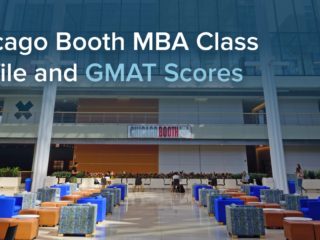| Getting your Trinity Audio player ready... |
Are you thinking of applying to the MBA program at Northwestern University’s Kellogg School of Management? Then you’re probably thinking about taking the GMAT and what GMAT score you’ll need to be a competitive applicant.
In this article, we’ll take a look at MBA admission statistics that can help you determine what kind of GMAT score will get you noticed when applying to Kellogg’s full-time MBA program. In particular, we’ll examine Kellogg’s MBA class profile, the Kellogg GMAT score average, and Kellogg’s GMAT score range. We’ll also discuss how to use class profile information to set your GMAT score goal.
Here are all the topics we’ll cover in this article:
- Is Kellogg’s MBA Program Considered Prestigious?
- Is Kellogg’s MBA Program Hard to Get Into?
- The Kellogg Class Profile
- Kellogg GMAT Scores
- What Is a Good GMAT Score for Kellogg?
- Does Kellogg Business School Require GMAT Scores?
- In Conclusion
- What’s Next?
First, let’s review some basics about Kellogg.
Is Kellogg’s MBA Program Considered Prestigious?
The Kellogg School of Management has one of the most prestigious full-time MBA programs in the world. An M7 school, Kellogg’s MBA program was tied at #3 among full-time programs on U.S. News’ 2024 list of the Best Business Schools. (Note that Kellogg also took the #3 slot among part-time MBA programs).
Is Kellogg’s MBA Program Hard to Get Into?
Like other M7 schools, Kellogg has a highly competitive admissions process.
That said, the question of whether Kellogg is “hard to get into” will have a different answer for each applicant. For someone with a high GPA, great test scores, and glowing recommendations, Kellogg might not be as “hard to get into” as it will be for someone whose profile is lacking in those areas.
Nevertheless, in comparison to, say, the top 25 MBA programs, a top 5 school such as Kellogg would generally be considered “hard to get into.”
KEY FACT:
Like other M7 schools, Kellogg has a highly competitive admissions process.
To get a better sense of how competitive Kellogg’s admissions process is, let’s look at the MBA program’s acceptance rate.
The Kellogg MBA Program Acceptance Rate
Kellogg’s class of 2025 had 4,316 applicants, with a 32% acceptance rate. For the class of 2026, Kellogg did not publicly disclose application data. However, the reputable source Poets & Quants reported a 23% increase in the number of applicants from the previous year.
With an increase in the number of applicants but no corresponding increase in student capacity, we would estimate that the acceptance rate for the class of 2026 is roughly 27%. So, it appears that about one out of every four students applying to Kellogg’s full-time MBA program is accepted.
KEY FACT:
The acceptance rate of Kellogg’s full-time MBA program is about 27%.
Given that Kellogg is so selective, it’s no surprise that its class of 2026 boasts some pretty impressive stats. Let’s take a look at the full-time MBA program’s class profile.
The Kellogg Class Profile
As you might expect, the Kellogg class profile is consistently impressive. The class of 2026 is no exception. Let’s take a look at some key demographic information for the MBA class for the past few years.
| Class of … | Average GPA | Average Years of Work Experience | Female | International | Underrepresented Minority |
|---|---|---|---|---|---|
| 2026 | 3.7 | 5 | 50% | 40% | 7% |
| 2025 | 3.7 | 5 | 48% | 39% | 19% |
| 2024 | 3.7 | 5 | 48% | 38% | 23% |
As we can see, the average work experience of Kellogg full-time MBA students has held steady at 5 years. This number is right in line with the averages at other top MBA programs.
Notably, the class of 2026 boasts a record-high percentage of female students, the highest percentage in Kellogg’s history. Also, the class of 2026 saw a 63% decrease from 2025 in the percentage of underrepresented minority students. This may be due in part to the 2023 ruling by the U.S. Supreme Court that made it unlawful for schools to consider race as a specific factor in college admissions.
KEY FACT:
The class of 2026 experienced a 63% decrease from 2025 in the percentage of underrepresented minority students.
Now, let’s take a closer look at the academic and professional backgrounds of students admitted to Kellogg’s MBA program.
Kellogg MBA Program: Undergraduate Degrees
As we can see above, for two of the past three years, roughly half of the members of Kellogg’s MBA class have had an undergraduate degree in business. STEM degrees have been the second most popular among Kellogg’s MBA class, and humanities degrees the third.
KEY FACT:
For the past two years, roughly half of the members of Kellogg’s MBA class have had undergraduate degrees in business.
Kellogg MBA Program: Top 3 Industries
As we can see, the class of 2026 marked a significant increase in the percentage of admitted students with consulting backgrounds. The one-year percent increase for the class of 2026 was 23% from the previous year. Note that admitted students from the financial services and technical sectors have seen their percentages remain relatively unchanged.
KEY FACT:
For the 3-year period displayed, consulting remained the most common industry for Kellogg’s incoming class.
This data will come in handy when we discuss setting your Kellogg GMAT score goal, later in this article. For now, let’s take a look at the GMAT scores of Kellogg students.
Kellogg GMAT Scores
Kellogg School of Management GMAT scores are — no surprise — impressively high. That said, they are right in line with the average GMAT scores and GMAT ranges of other M7 schools. Let’s have a look at Kellogg GMAT scores for the three most recent incoming classes. Note that when we discuss GMAT scores, we are using “legacy” GMAT scores, those prior to November 7, 2023, for the sake of comparison. To convert legacy GMAT scores to post-2023 scores, use the GMAT concordance table from GMAC.
Kellogg MBA Average GMAT Scores and GMAT Ranges: 2024-2026
| Class of … | GMAT Mean | GMAT Median | GMAT Range |
|---|---|---|---|
| 2026 | 733 | 740 | 640-780 |
| 2025 | 731 | 731 | 620-780 |
| 2024 | 729 | n/a | 620-780 |
Upon first glance, we might think that 730 is “the magic number” when submitting a GMAT score to Kellogg. After all, for these three years, both the mean and median GMAT scores have roughly hit that target.
However, we should note the GMAT ranges associated with each MBA class. For example, the classes of 2024 and 2025 showed admissions with GMAT scores from 620 to 780, a 160-point swing. And not far behind that is the class of 2026’s 140-point range of GMAT scores. What could explain such a wide range of scores among accepted students? And what do those GMAT ranges mean for your score goal? Can you be competitive at Kellogg with a score in the mid-600s? Do you need to aim for a score in the high 700s? Let’s investigate.
What Is a Good GMAT Score for Kellogg?
Generally speaking, a good GMAT score for any MBA program is equal to the average GMAT scores of admitted students. In reality, however, the average GMAT scores of an MBA class are merely a starting point when setting your goal. The fact is, a “good” GMAT score for one person may not be so good for another. After all, admissions weighs a host of factors when considering each applicant. Your GPA, work experience, academic and personal background, recommendations, application essays, etc., will all come into play. Furthermore, no two applicants, regardless of test scores and GPA, will ever be exactly alike.
So, while Kellogg’s standards are undoubtedly high, there is no one set of “magic numbers” that every applicant must have. With that in mind, when setting your GMAT score goal, you need to think like admissions. In other words, weigh your strengths and weaknesses, rather than assume that hitting an average will earn you admission.
TTP PRO TIP:
All else equal, a good GMAT score for Kellogg will generally be equal to the incoming class average.
To illustrate this point, let’s consider a few common scenarios, using data from Kellogg’s class of 2026.
Scenario #1: You’re in an Overrepresented Group
People in groups that are overrepresented in MBA admissions typically need to earn higher GMAT scores in order to stand out among a sea of similar applicants. So, let’s say you’re a white male with an undergraduate business degree, a GPA of 3.7, and about 5 years of work experience in consulting. In that case, going by Kellogg’s class of 2026 — and prior classes — you would certainly be overrepresented among applicants. (Note that Kellogg’s class of 2026 is majority white and 50% male.) In fact, you can bet that a high proportion of applicant profiles will look very similar to yours.
So, a GMAT score of 685 (730 on the legacy scale) may not do much to make your application shine. In other words, if your GMAT score meets the average, then your profile will, by Kellogg’s standards, essentially be average.
Thus, to make yourself stand out, a smart play would be to shoot for a GMAT score above the average. Particularly if you are overrepresented in several respects, as our imaginary applicant above is, consider aiming for a GMAT score that approaches the top end of Kellogg’s GMAT range.
TTP PRO TIP:
If you are in an overrepresented group, aim for a GMAT score that beats the Kellogg average and possibly approaches the top end of the Kellogg GMAT range.
Scenario #2: You’re in an Underrepresented Group
Let’s say you’re a black woman with an undergraduate degree in engineering, a GPA of 3.9, and 6 years of work experience in the energy sector. In that case, your applicant profile will be fairly uncommon at Kellogg. (Only 3% of the class of 2026 identifies as black and only 1% of the class hails from the energy industry.) Furthermore, your GPA and years of work experience both beat the class averages.
Since your applicant profile already stands out in other respects, you may be quite competitive applying to Kellogg with, say, a GMAT score of 655 or 665 (700 or 710 on the legacy scale). Of course, only you know whether there are weaknesses in your application that high test scores could help compensate for.
Furthermore, you should keep in mind that top MBA programs typically prefer to see GMAT Quant scores of 80 (47 on the legacy scale) or higher. Additionally, business schools generally prefer to see fairly “balanced” GMAT section scores. So, a high Quant score alongside a seriously lacking Verbal score might not look so great.
With all of this in mind, even if you are from an underrepresented group, a safe bet would be to aim to at least meet the Kellogg average GMAT score.
TTP PRO TIP:
Even if you are in an underrepresented group, a safe bet is to at least meet Kellogg’s average GMAT score.
Scenario #3: Your GPA is Below Average
No matter what your stats are in other admissions factors, if your GPA is notably lower than the Kellogg average, your best bet is to aim for a GMAT score near the top end of the Kellogg GMAT range. How close to the top you should aim will depend on how far below the average your GPA is and what the other strengths and weaknesses in your profile are. Regardless, the GMAT can reassure admissions that you have what it takes to succeed in the MBA program.
In fact, if any area of your profile is lacking, the GMAT can help “balance the scales.” Perhaps your recommendations aren’t quite what you hoped they’d be, or your work experience is limited. The GMAT is a great opportunity — and one of the few — to make up for those weaknesses. Let’s face it, you can’t travel back in time to beef up your resume or improve your GPA. Your GMAT score is something you have control over right now. Make it count.
TTP PRO TIP:
If your GPA or other admissions factor is notably below the Kellogg average, aim for a GMAT score near the top end of the Kellogg GMAT range.
Does Kellogg Business School Require GMAT Scores?
To be considered for admittance to Kellogg’s full-time MBA program, you must submit either a GMAT or GRE score. Kellogg states that it does not prefer one test over the other. So, the choice is yours about whether to take the GMAT or the GRE.
If you’re unsure about which test to take, your best bet is to take an official, full-length practice test of each kind. Based on your performance on those initial practice tests, you should be able to determine which test you have the best chance of scoring highest on.
Keep in mind that regardless of which test you ultimately take, Kellogg sets the bar pretty high. For the class of 2026, Kellogg’s median GRE scores are Q163/V162. Thus, most students need to put some serious time and effort into their test prep to reach their score goals. In other words, there is no “easy way out.” So, if you’re wondering whether you can avoid the long, hard road of GMAT prep by simply switching to the GRE, trust me when I say that GRE prep can be just as intense!
KEY FACT:
To be considered for admission to Kellogg’s full-time MBA program, you must submit either a GMAT or GRE score.
In Conclusion
Remember, whatever your GMAT score goal, with the right attitude and a smart study plan, you CAN earn the score you need to be competitive at Kellogg. Consider the GMAT as one more opportunity to show off your skills to admissions, and do everything you can to take advantage of that opportunity!
Consider the GMAT one more opportunity to show off your skills to admissions, and do everything you can to take advantage of that opportunity!
What’s Next?
Thinking of applying to other top business schools like Kellogg? Check out this guide to GMAT scores at top MBA programs.
Already know your score goal? Get help reaching it with these strategies for scoring 705+ and this guide to scoring a perfect 805 on the GMAT.



